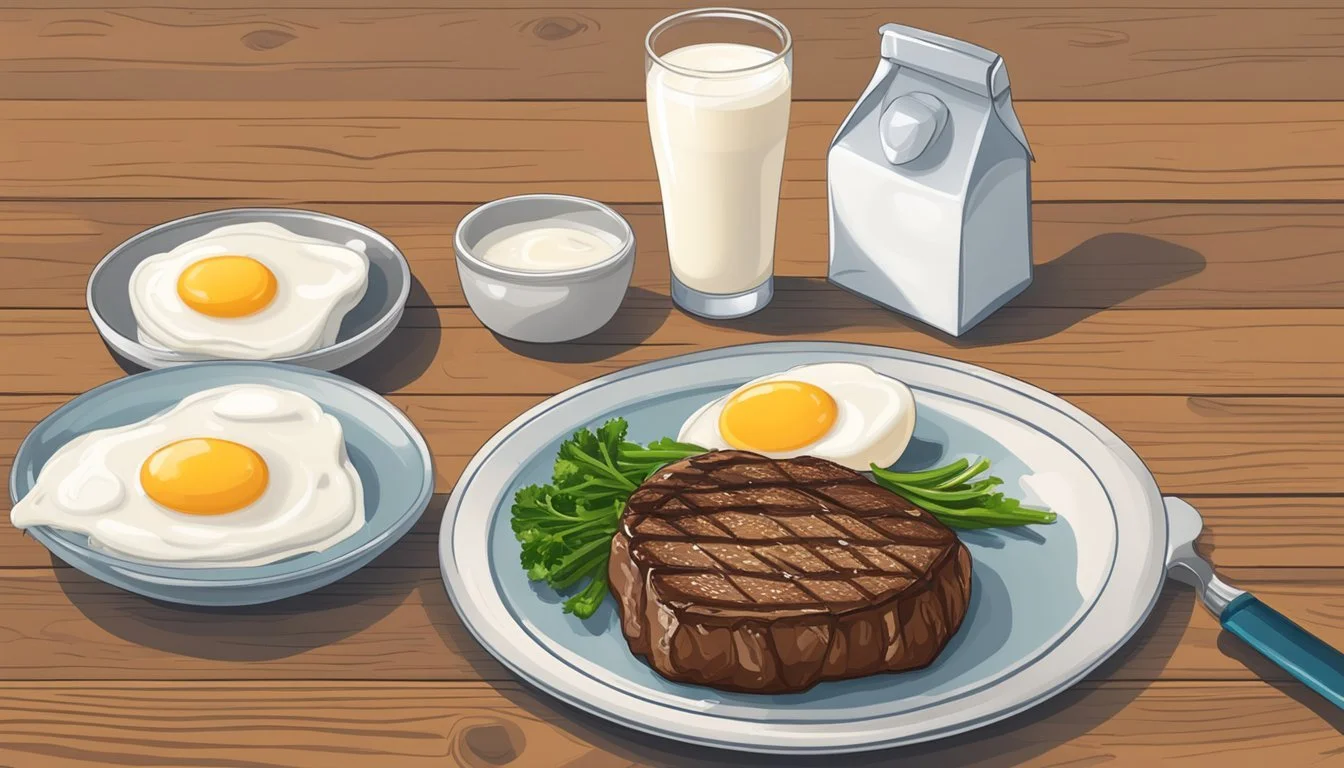The Carnivore Diet for Ballroom Dancers
Unleashing Peak Performance
The carnivore diet, consisting primarily of animal products such as meat, organs, eggs, and select dairy, has been a subject of intrigue across various athletic disciplines. For ballroom dancers, where grace, stamina, and strength are pivotal, nutrition plays a crucial role in performance. While typically a balanced diet including carbohydrates, proteins, and fats is recommended, the carnivore diet shifts the focus to a high-protein, high-fat intake, potentially offering an alternative source of sustained energy for extended training and performances.
Adapting to a carnivore diet could influence a dancer's energy levels and muscle recovery. The high protein content serves as the building block for muscle repair, which is essential considering the physical demands of ballroom dancing. However, it is also important to consider the potential absence of certain nutrients typically obtained from fruits, vegetables, and whole grains. Dancers must ensure that they are not compromising their overall health while adopting such a restrictive dietary pattern.
Therefore, when considering the carnivore diet, ballroom dancers must evaluate their unique nutritional needs, the intensity of their training schedules, and any personal health concerns. Consulting with a healthcare provider or a dietitian with experience in sports nutrition can offer valuable insights and help tailor the diet to support optimum performance levels.
Carnivore Diet Basics
The Carnivore Diet for ballroom dancers focuses on high-protein and fat intake from animal sources with zero carbohydrates from plants, aiming to enhance energy, muscle resilience, and overall dancer performance.
Defining the Carnivore Diet
The Carnivore Diet consists solely of animal products such as meat, dairy, eggs, and fish. It provides essential nutrition including protein, fats, and micronutrients like vitamins and minerals. Carbohydrates and fiber are notably absent from this dietary regimen.
Comparison to Other Diets
Unlike diets that allow or emphasize plant-based foods, the Carnivore Diet excludes such items completely, focusing instead on animal foods. It is higher in protein and animal fat compared to a standard omnivorous diet and differs significantly from vegan or vegetarian diets, which contain no animal products.
Common Misconceptions
A common misconception is that the Carnivore Diet leads to fatigue due to a lack of carbohydrates. However, many adherents report sustained energy levels, likely due to the body's adaptation to using fat for fuel. Moreover, while it might seem restrictive, the diet includes a variety of animal products, ensuring a broad intake of different nutrients essential for maintaining a dancer's grace, stamina, and strength.
Nutritional Profile of a Carnivore Diet
When discussing the carnivore diet from a nutritional perspective, it is essential to consider both the comprehensive macro and micronutrient profiles it offers and the risk of potential deficiencies, particularly given the high demands of ballroom dancing.
Macronutrient Breakdown
Protein: The carnivore diet is rich in protein, a crucial macronutrient for muscle repair and growth. Ballroom dancers can benefit from sources such as:
Meat: Ribeye steak (What wine goes well with ribeye steak?), chicken, turkey
Fish: Salmon, mackerel, cod
Eggs
Fats: Dietary fats from animal sources are abundant in the carnivore diet:
Saturated Fats: Found in bacon, cheese, and butter
Omega-3 Fatty Acids: Present in fatty fish like salmon and mackerel
Micronutrient Considerations
Vitamins and Minerals: Animal-based foods provide various vitamins and minerals essential for a dancer's energy and bone health:
Vitamin B12: Abundant in liver and meat
Vitamin D: Found in fatty fish and eggs
Calcium: Available in cheese and bone broth
Sodium: This diet includes naturally occurring sodium, seen in preserved meats and added for flavor. For dancers, adequate sodium intake supports hydration and muscle function.
Vitamin C: Although less common, certain organ meats like liver can offer vitamin C, reducing the risk of deficiency in the absence of fruits and vegetables.
Potential Nutrient Deficiencies
While the carnivore diet can provide most nutrients from animal sources, there are concerns regarding potential deficiencies:
Fiber: Absent due to the lack of plant-based foods, impacting digestion
Vitamin C and E: Lower intake compared to diets that include plant foods
Phytonutrients: Not present, which may affect long-term health outcomes
Dancers should monitor their health and consult with nutrition professionals to ensure their dietary needs are met, especially if considering the carnivore diet.
Make your life easier by ordering fiber supplement, vitamin C, and vitamin E online; it's just a few clicks away!
Health Implications
The Carnivore Diet for ballroom dancers poses unique health implications affecting weight management and chronic diseases. It's crucial for dancers to understand these impacts, particularly in relation to heart health and hypertension.
Weight Management
Ballroom dancers often focus on maintaining a lean physique for performance aesthetics. The Carnivore Diet, primarily consisting of meat, fish, and animal products, may contribute to weight loss due to its low-carbohydrate nature. This diet can lead to a state of ketosis, where the body burns fat as its primary source of energy, potentially resulting in weight reduction. However, dancers should be wary that abrupt or excessive weight loss can jeopardize stamina and muscle strength.
Weight Loss: Potential due to reduced carbohydrate consumption.
Obesity Prevention: May be influenced by satiety from high protein intake.
Chronic Diseases and Conditions
The restriction of plant-based foods can have implications for chronic diseases. The consumption of red and processed meats has been associated with an increased risk of certain chronic diseases such as type 2 diabetes, cancer including colon and colorectal cancers. Ballroom dancers considering this diet should balance the need for a diverse array of nutrients against the potential increased risk of these conditions.
Diabetes Risk: Increased with diets high in red and processed meat.
Cancer Risk: Elevated for colon and colorectal cancer with high red meat (What wine goes well with red meat?) intake.
Heart Health and Hypertension
Heart health is paramount for ballroom dancers, who require endurance and cardiovascular fitness. A diet high in saturated fats, often found in animal products, can contribute to heart disease and high blood pressure. It is essential for dancers on the Carnivore Diet to choose lean meats and monitor their cholesterol and blood pressure regularly to mitigate these risks.
Heart Disease: Risk may be increased with high saturated fat intake.
Hypertension: Monitoring blood pressure is vital due to potential dietary influences.
Performance and Recovery Advantages
In evaluating the carnivore diet's influence on ballroom dancers, the focus on energy, muscle repair, and inflammation reveals potential benefits for both performance and recovery. These athletes may experience enhanced stamina and strength, which are crucial for the rigorous demands of training and competition.
Energy Provision for Dancers
Ballroom dancers require a steady supply of energy to perform with grace and precision. A ketogenic approach within a carnivore diet can shift energy utilization from glycogen to ketones, derived from fats. Healthy fats from the carnivore diet provide a longer-lasting energy source, which could benefit dancers in prolonged rehearsals and performances.
Glycogen: Typically utilized during high-intensity dances.
Ketogenic Energy: May improve endurance during back-to-back performances.
Muscle Repair and Stamina
Dancers subject their muscles to strenuous activity, necessitating efficient repair for sustained stamina. The high protein content of the carnivore diet supports muscle repair and growth.
Protein: Essential for repairing muscle tissue post-training.
Strength: Facilitated by sufficient protein, important for lifts and leaps.
Inflammation and Recovery
Inflammation can severely affect a dancer's recovery time and overall well-being. The carnivore diet, rich in healthy fats, may help manage inflammation. As inflammation subsides, recovery accelerates, allowing dancers to return to training sooner with less risk of injury.
Inflammation: Managed by omitting inflammatory plant-based foods.
Recovery: Improved recovery times have been anecdotally reported by athletes on high-protein, high-fat diets.
Benefits and Challenges
In the demanding world of ballroom dancing, dancers seek diets that bolster grace, stamina, and strength. The Carnivore Diet, known for its low-carb approach, raises questions about its potential benefits and inherent restrictions.
Possible Health Benefits
Success in Performance: Ballroom dancers may find that the high-protein and fat-centric Carnivore Diet can support muscle maintenance and energy required for their activities. Health Benefits: A ketogenic state, often achieved with this diet, may provide sustained energy levels, essential for lengthy rehearsals and performances.
Weight Management: Low-carb diets have been linked to weight loss, which may contribute to dancers' agility.
Mental Clarity: Some individuals report heightened focus and mental clarity, possibly due to the ketosis state.
The Debate on Long Term Sustainability
Sustainability Concerns: Critics argue that the Carnivore Diet might not be sustainable in the long term because of its highly restrictive nature.
Nutrient Deficiencies: A lack of variety could lead to nutritional imbalances.
Medical Guidance Recommended: Long-term adherence should be monitored by healthcare professionals to mitigate health risks.
Dietary Restrictions and Social Impacts
Restrictive Diet: This diet excludes plant-based foods, making it one of the most restrictive dietary approaches.
Impact on Social Eating: Its restrictive nature could impact social interactions around food.
Potential for Disordered Eating: The extreme exclusion may heighten the risk for developing or exacerbating eating disorders.
The choice to follow the Carnivore Diet for a ballroom dancer involves weighing its potential to enhance performance against the possibility of it leading to a nutritionally unbalanced dietary pattern.
Practical Tips for Implementation
Adopting the carnivore diet can enhance a ballroom dancer's performance by providing high-quality protein for muscle development and repair. Below are targeted strategies for starting, planning, and managing the unique challenges of this diet.
Starting the Carnivore Diet
One initiates the carnivore diet by focusing on meat, fish, and animal products like eggs and certain dairy. Organ meats are highly recommended for their nutrient density. A gradual transition into this diet is beneficial to adjust to higher saturated fat intake while tapering off carbohydrates.
Red meat (beef, lamb)
Poultry (chicken, turkey)
Fish and shellfish
Organ meats (liver, heart)
Eggs
Low-lactose dairy products
Foods to Avoid:
High-carbohydrate foods (grains, sugars)
Legumes
Alcohol (can impede performance and recovery)
Gradual Transition:
Week 1-2: Reduce carbohydrate intake while increasing meat and fish
Week 3-4: Incorporate organ meats and eggs
By Week 5: Aim to have a fully carnivorous diet
Meal Planning and Preparation
Meal planning is crucial to adhere to the diet and ensure adequate nutrient intake. Dancers should pre-plan their meals to include a variety of meat and fish to prevent nutrient deficiencies and dietary boredom.
Breakfast: Scrambled eggs with a side of bacon
Lunch: Grilled chicken salad (no dressing)
Dinner: Pan-seared salmon with a serving of liver
Food Prep Tips:
Cook in bulk to save time
Use animal fats for cooking to enhance flavor and caloric content
Always have a ready stock of boiled eggs or canned fish for quick snacks
Managing Side Effects and Cravings
Transitioning to a zero-carb diet can lead to cravings and side effects. Stay well-hydrated, as increased protein consumption requires more water. For carbohydrate cravings, it's advised to eat fattier cuts of meat to provide satiety and energy.
Dealing with Cravings and Side Effects:
Drink at least 2 liters of water daily
If experiencing cravings, opt for a high-fat snack like a piece of cheese or a few slices of bacon
Monitor your body's response to the diet and adjust meat selections accordingly
Cravings Management:
For sweetness: Choose dairy like cheese or yogurt (watch for lactose content)
For satiety: Opt for fatty fish or red meat
For variety: Rotate the types of meats and fish consumed weekly
Considerations for Dancers
For ballroom dancers, leveraging the benefits of a carnivore diet involves careful balancing of nutritional intake and understanding the specific demands of dance routines.
Tailoring the Diet to Dance Routines
The carnivore diet, high in protein and low-carb, can be adjusted to support the intense training of ballroom dancers. They need energy for quick movements and endurance for long sessions, which typically comes from carbohydrates. Incorporating strategic carb intake around intense dance sessions may help sustain stamina and performance.
Before Training: A small portion of dairy or eggs for a blend of fats and minimal carbs.
Post-Training: Prioritizing protein-rich foods like meat to aid in muscle repair.
Hydration and Electrolyte Balance
Hydration cannot be overstated for dancers on a low-carb diet. Adequate water intake is crucial, and maintaining electrolyte balance is essential for preventing muscle cramps and maintaining energy levels.
Daily Water Intake: At least 8-10 glasses, more if training is intense.
Electrolytes: Natural sources like eggs and seafood, or supplements if necessary.
Combining Dance with Diet for Optimal Performance
A well-rounded approach that meshes the carnivore diet with ballroom dancing enhances dancers' ability to perform with grace and strength. Protein provides the building blocks for muscle repair, while fat can offer sustained energy when dancers adapt to lower carb intake. Listening to the body's signals and adjusting food choices and portions accordingly optimizes health and performance.
Nutrient Timing: Aligning food intake with training demands for energy optimization.
Dietary Adjustment: Introducing carbs in moderation can be considered when intense training demands it.
Expert Views and Research
This section explores the diverse opinions of dietitians and the evidence presented in scientific research concerning the carnivore diet's impact on ballroom dancers and their performance.
What Dietitians Say
Dietitians emphasize balanced nutrition to support the high energy demands and physical exertion of ballroom dancers. They are generally cautious about extreme diets such as the carnivore diet due to potential nutritional deficiencies. A diet consisting only of animal products can lack essential vitamins, minerals, and fiber found in a varied diet, which could affect dancer's overall energy levels and muscle recovery.
Nutrient Concerns: Vitamin C, fiber, and certain antioxidants predominantly found in plants are absent from the carnivore diet.
Protein Focus: The high protein intake from the carnivore diet may support muscle maintenance and recovery, which is beneficial for dancers.
Health Risks: Dietitians often discuss the long-term health risks of high saturated fat and cholesterol intake associated with red and processed meats.
Scientific Research and Studies
Research on the carnivore diet is limited, but some studies suggest potential benefits and drawbacks that are crucial for athletes such as ballroom dancers.
Energy Metabolism: Studies suggest that high-fat, low-carb diets can alter energy utilization, shifting from carbohydrates to fats for energy, which might affect stamina.
Physical Performance: Limited evidence is available on the carnivore diet's impact on strength and endurance, key components for dancers.
Adaptation Period: Researchers acknowledge an adaptation period where athletes might experience initial fatigue before potential performance stabilization.
The scientific community generally calls for more comprehensive studies to understand the diet's long-term effects on athletes' health and performance.
Conclusion
Ballroom dancers require a diet that supports their intense physical demands, including the need for sustained energy, muscular strength, and recovery. While the carnivore diet eliminates plant-based foods such as grains, vegetables, fruits, nuts, seeds, and legumes, it focuses on animal products that provide high levels of protein and fat.
This dietary approach can influence metabolic health, aiding some individuals in managing insulin resistance due to reduced carbohydrate intake. However, it is essential to monitor kidney function, as a diet high in protein can strain the kidneys over time. The exclusion of fiber-rich plant foods may also affect gut health, with potential implications for overall well-being and effective nutrient absorption.
In contrast to the diverse nutrients offered by a traditional diet, the modified nutritional profile of the carnivore diet may require dancers to be mindful of potential deficiencies. While the diet promotes intake of various meats and possibly low-lactose dairy, other nutrients typically found in a broader diet must be considered.
For mental health, the restriction imposed by the carnivore diet may affect an individual's relationship with food and long-term psychological satisfaction, which must be taken into account.
In short, dancers contemplating the carnivore diet should carefully weigh its compatibility with their health needs and the demands of their training and performance schedules. They should consult nutrition and health professionals to ensure the diet does not compromise their overall health or performance ability.












